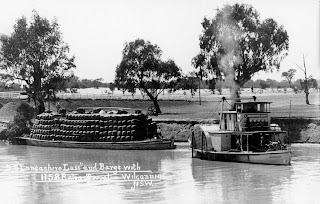As always my gaming focus swings wildly.
With the release of Matthew Clarkson's magnificent tome
A Right Bloody Mess in 2017 and more recently Mana Press's
Maximilian 1934 rules and the wonderful supporting ranges from
Eureka Miniatures (OK plugs over now!) my mind has turned to 'what if?' conflicts in the parched plains of this great, big brown land of ours.
I have been experimenting with Eureka Miniatures 'The Cars that ate Murrumbeena' range and there will be posts to follow on that. Today is just a little taster of the riverine consequences of this civil disturbance in Australia in the 1930s. Currently a work in progress.
My mind has been turning to monolithic dredges from the gold mining era being hauled across dry landscapes by traction engines to fight battles in the ephemeral, mineral leaden lakes of the interior - my take on American Civil War Cotttonclads - but I need to start a little smaller than that!
 |
| USS Morning Light - an American Civil War Cottonclad |
Today I give you a peek of my first addition to the riverine fleet for ARBM - the converted wool barge Willandra.
 |
| The Murray Barge Dart |
The Willandra is based on a real barge of the late 1800s (but no accurate dimensions could be found - so I faked it). She was built in 1879 and plied the Murray-Darling rivers as a barge for the Paddle Steamer Alert. These barges and the whole riverine transport system slowly declined with the spread of the road and rail network and many boats fell into disrepair. Now, I diverge from history.
With the outbreak of hostilities in the 1930s (see Matthew's ARBM) the road and rail network was again compromised by the warring factions. The massive (although ephemeral and unreliable) Riverine transport network of the Murray-Darling Basin flourished again. Old barges (once towed by Paddle Steamers) were retrofitted with diesel engines and pressed into service - valued for their shallow draft in these rivers full of sandbanks and snags.
Here we see the owner of sheep station at
Minindee along the Darling River in NSW on a run down to the market in Mildura to sell some of her high grade Merino wool - in great demand again for uniforms as the various militia kit up across the region!
But, soon enough, as resources become scarce due to the break down of trade across this huge continent, the trip to market becomes fraught with danger from attacks by land-based militia and even the occasional attack from small watercraft. Only last month an aged paddle steamer was sunk in the Murray River by spar torpedo boats from a timber-cutter gang turned feral in
Barmah! The militia need uniforms so the wool must get through to the markets. Thus, the first 'woolclad' gunboat on the darling River is born - the Willandra! More to follow...
 |
| The Hotchkiss Gun, Nordenfelt and Wool Bales are all from Eureka Miniatures, The Willandra is scratch-built of cork, MDF and plastic card. The other figures at from Bob Murch - Pulp Figures |
Update:
The 'woolclad' Willandra is complete and ready to start plying her trade up and down the Darling shipping wool to the market in Mildura. Mimosa Herridge, the matriarch of Menindee Station is accompanying her shipment of the finest Merino wool down river.
Stopping to pick up a shipment from the neighboring property, Herridge is surprised to find a newsreel crew waiting for their arrival. The NSW Government's recently formed Ministry of Information wants to calm the jittery investors in Sydney by reinforcing that the State's rurl industries were still thriving despite the recent conflict.
The arrival of Herridge is a godsend for Ken G Hall the Movietone crew Director, Ken G Hall, but the Ministry's 'advisor' Major GPW Meredith (yes, the infamous commander of the failed Emu War!) quickly advises the crew to crop the armaments on the Willandra out of the shot as it doesn't send the right message!






















































